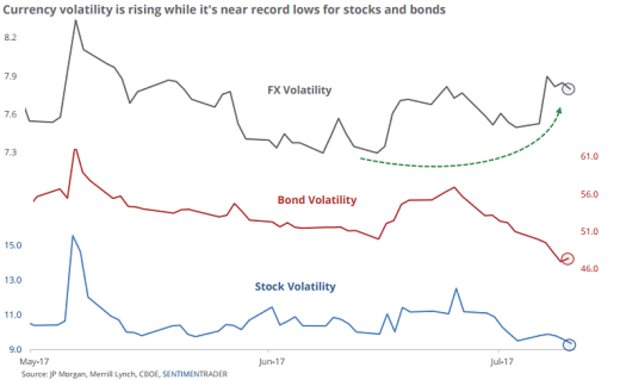A sliding dollar could spark volatility on Wall Street
Equity investors could hardly plan a better situation: It has been more than a year since the last serious sell-off, stock prices seem to hit a new record high each day and volatility is nearly nonexistent. Through Friday, the tech-heavy Nasdaq Composite was up for 11 of the last 13 sessions. Amazon (AMZN) is back over the $1,000-a-share threshold.
All is right in the world.
This calm situation in equities stands in contrast to a number of negative dynamics in play, including a decline in GDP growth expectations, consumer apprehension, a Federal Reserve preparing to unleash "quantitative tightening" as soon as September and deepening political dysfunction in Washington.
If stocks -- and the bond market, too, for that matter -- are ignoring these headwinds, the currency market is beginning to take notice. As Wall Street's post-election excitement fades, the U.S. dollar has fallen nearly 10 percent to test the bottom of a three-year sideways range. That has returned the greenback to lows not seen since early 2016.
Should the weakness accelerate, it could destabilize currency "carry trades" (using a currency in which interest rates are low to buy one with higher rates), fuel further demand for cryptocurrencies like bitcoin and bolster gold. It could also push inflation higher via rising commodity and import prices.
The rise in currency volatility (chart above) was enough to catch the eye of Jason Goepfert at SentimenTrader, who cited the Wall Street adage about market chaos first showing up in currencies. The action in that market stands in stark contrast to the historic lack of movement recently in the stock and bond markets.
The dollar's weakness, on a technical basis, is at its most extreme since 2011. The decline is of a severity, when seen in the past coming off a high, that has led to further losses every time between the next one to three months, according to Goepfert. He noted that "momentum like this in currency markets tends to persist."
That presages a spillover of volatility into stocks and bonds. Historically, when a setup like this (complacency in stocks and bonds, rising volatility in currencies) happens, it has preceded trouble for stocks. Since 1993, six such setups have occurred. Two months later, the S&P 500 was down 4.7 percent on average.
Looking ahead, the Federal Reserve will hold a two-day policy meeting starting on Tuesday. While a rate hike isn't expected, all eyes will be on the Fed's post-meeting announcement for clues on its views of the economy in light of recent inflation weakness.
This is also the last meeting before the Fed is expected to start its balance-sheet normalization program in September, dubbed "quantitative tightening," or QT, for those in the know.
To tip their hat at this, Deutsche Bank economists expect Fed officials to firm up its balance-sheet guidance to indicate that the "Committee currently expects to begin implementing a balance sheet normalization program at upcoming meetings."
This could very well uncork the equity market volatility that the dollar's decline is suggesting. It would mean the Fed is serious about draining the trillions in excess liquidity sloshing around the financial system. This is the very liquidity that has helped pad asset values and quell price movements for years.
Removing that money would be the catalyst for a comeback in stock and bond market volatility.





